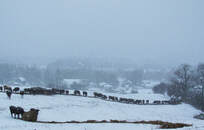CONSERVATION CORNER
A weekly blog for all things conservation
 By: Guest Columnist, Troy Bishopp, Grazing Specialist, Upper Susquehanna Coalition It’s amazing how ignorant I have been in following the tradition of feeding hay to my animals. Once you’re in this agricultural paradigm for so long it’s hard to break the cycle of thinking. It wasn’t until I actually looked at my farm’s displaced fertility levels from a nutrient management plan that I started to question my hay feeding practices and the labor it took. Tradition for me and my ancestors was feeding hay close to the barn, in the barn or on a convenient paddock that turned into a muddy quagmire. I utilized homemade wooden skid feeders, hay wagons and bale rings, much to the delight of the cows. They like playing the game of “who can pull out the most hay and waste it” game. Even as this was going on for years, I seemed paralyzed to change the situation because I fell into the trap of thinking cows couldn’t survive without being near a barn.
Change doesn’t come easy when the old-timers keep reminding you, “That’ll never work in a Northeast winter”. Three things happened to shake my brain cells loose: I read a lot of back issues from the Stockman Grass Farmer and 1930’s vintage agricultural books; met some very successful out-wintering cattle farms; and saw my soil tests were all the nutrients on my 100 acre farm were confined to about 20 acres. With increased input costs, old equipment, older bones, and lazy cows, you have a recipe to alter your mind. It seems foolish to ride the feed and cleanup merry-go-round when the cows can do it all with a little planning and management. My winter feeding formula is to first; try and plan to graze longer into the season by utilizing stockpiled forage. Second; move feed (I now buy all my feed) to where you need the nutrients (usually the farthest field from the barn) before winter and third; move the cows to the feed and close the gate. Sound simple? When it works like that it could be. It wasn’t without work however as rolling out round bales in the snow can be challenging, but I saved money on a gym membership. I would recommend pushing bales downhill or on the level. Rolling out a bale of hay is like spreading a load of manure. This is especially advantageous if the terrain doesn’t allow for much equipment. The cows eat the hay, defecate and lay down, and transfer nutrients to the ground. Ohhh, the waste you say! Research has shown me that a ton’s worth of these big bales are worth 60 bucks just for fertilizer value alone with today’s fertilizer prices, plus the 800 lbs of organic matter and other micro-benefits gobbled up by the soil flora. In addition, if you only roll out enough hay for 1 day, the wastage should only run around 10%. Compare that with 5-8% around ring feeders but add in the fertilizer benefits and advantages of allowing more access from timid animals and it makes sense to look at a different paradigm. This simple strategy has totally transformed those fields with the familiar pale grass with spotty urine patches of green into a dense, thick carpet of diverse forage teaming with biological life, all in one season. It’s truly remarkable to witness the transformation and all it took was a change in behavior. The next time you’re frustrated with the bale-ring dead spots think about the possibilities of what you can do on your farm. Even if you could graze a little longer or feed out in the back reaches of the property for a month, it’s worth the effort. Spring grass with a full root system and packed with nutrients makes you money. That’s something good for the wallet and the environment. Roll with it! The Bradford County Conservation District is committed to helping people manage resources wisely. You can visit the Bradford County Conservation District at 200 Lake Rd in Wysox across from the Wysox Fire Hall. Contact us at (570) 485-3144 or visit our web page at www.bccdpa.com.
0 Comments
Leave a Reply. |
AuthorsVarious staff at the Bradford County Conservation District Archives
April 2024
Categories
All
|
